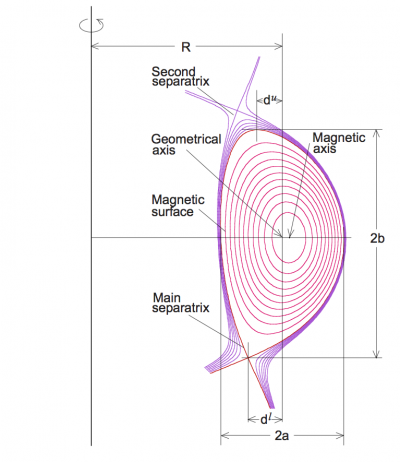Triangularity: Difference between revisions
Jump to navigation
Jump to search
No edit summary |
Mention how triangularity affects the plasma and mention negative triangularity. |
||
| Line 12: | Line 12: | ||
and similar for δ<sub>lower</sub>. | and similar for δ<sub>lower</sub>. | ||
The overall triangularity is defined as the mean of δ<sub>upper</sub> and δ<sub>lower</sub>. | The overall triangularity is defined as the mean of δ<sub>upper</sub> and δ<sub>lower</sub>. | ||
Triangularity, especially the triangularity opposite the dominant X-point (so upper triangularity for a lower null plasma), influences the stability and character of the [[pedestal]] and [[Edge Localized Modes|ELMs]].<ref>[[doi:10.1088/0741-3335/42/5A/319|T.H. Osborne, et al., Plasma Phys. Control. Fusion '''42''' (2000) A175]]</ref> | |||
Some devices (TCV and DIII-D) can form plasma cross sections with negative triangularity (the X-points are pushed to larger <math>R</math> than the center of the plasma), which makes H-mode difficult or impossible to access but improves performance of the L-mode.<ref>[[doi:10.1088/1741-4326/abdb95|W. Han, et al., Nucl. Fusion '''61''' (2021) 034003]]</ref> | |||
== See also == | == See also == | ||
Revision as of 06:35, 28 March 2023

The triangularity refers to the shape of the poloidal cross section of the Last Closed Flux surface (LCFS) or separatrix of a tokamak. Assuming[1]:
- Rmax is the maximum value of R along the LCFS or separatrix.
- Rmin is the minimum value of R along the LCFS or separatrix.
- Rgeo is the geometric major radius, defined as (Rmax + Rmin)/2.
- a is the minor radius of the plasma, defined as (Rmax - Rmin)/2.
- Rupper is the major radius of the highest vertical point of the LCFS or separatrix.
- Rlower is the major radius of the lowest vertical point of the LCFS or separatrix.
The upper triangularity is then defined as follows:
and similar for δlower. The overall triangularity is defined as the mean of δupper and δlower.
Triangularity, especially the triangularity opposite the dominant X-point (so upper triangularity for a lower null plasma), influences the stability and character of the pedestal and ELMs.[2]
Some devices (TCV and DIII-D) can form plasma cross sections with negative triangularity (the X-points are pushed to larger than the center of the plasma), which makes H-mode difficult or impossible to access but improves performance of the L-mode.[3]